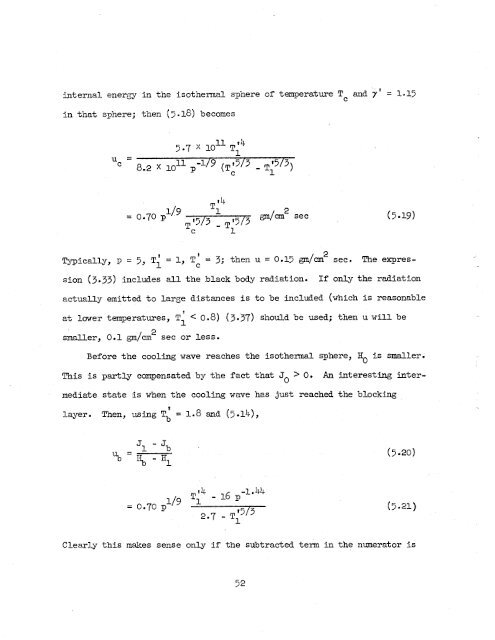Theory of the Fireball
Theory of the Fireball
Theory of the Fireball
You also want an ePaper? Increase the reach of your titles
YUMPU automatically turns print PDFs into web optimized ePapers that Google loves.
internal energy<br />
in that sFhere;<br />
in <strong>the</strong> iso<strong>the</strong>rmal sphere <strong>of</strong> temperature T and 7 ' = 1.15<br />
C<br />
<strong>the</strong>n (5.18) becomes<br />
Typically, p = 5, TI = 1, Tc = 3; <strong>the</strong>n u = 0.15 gm/cm sec. The expres-<br />
sion (3.33) includes all <strong>the</strong> black body radiation. If only <strong>the</strong> radiation<br />
actually emitted to large distances is to be included (which is reasonable<br />
at lower temperatures, Ti < 0.8) (3.37) should be used; <strong>the</strong>n u will be<br />
2<br />
smaller, 0.1 gm/cm sec or less.<br />
t I 2<br />
Before <strong>the</strong> cooling wave reacnes <strong>the</strong> iso<strong>the</strong>rmal sphere, Ho is smaller.<br />
This is partly compensated by <strong>the</strong> fact that Jo > 0. An interesting inter-<br />
mediate state is when <strong>the</strong> cooling wave has just reached <strong>the</strong> blocking<br />
layer. Tnen, using Tb<br />
t<br />
J1 - Jb,<br />
"b = 1% - H1<br />
= 1.8 and (5.14),<br />
Clearly this makes sense only if <strong>the</strong> subtracted term in <strong>the</strong> numerator is
















